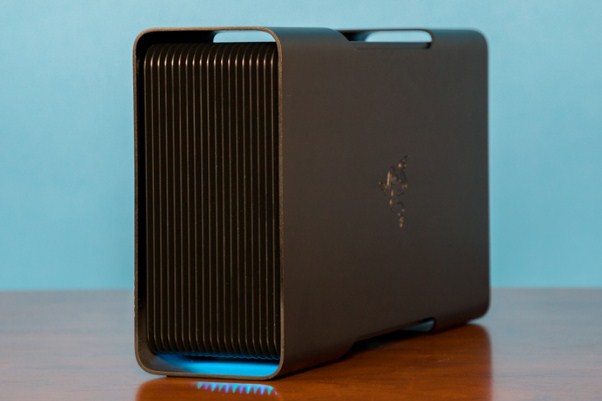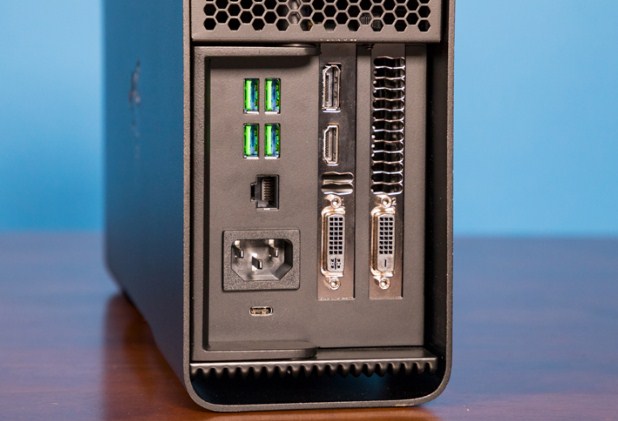Razer's multiplying down on the outside GPU advertise. The organization's second generation of the Core, the Core V2, holds the delightful lighting and good looking case that we've generally expected from Razer, with a couple of key refinements. The skeleton has gotten somewhat greater to help all the more capable GPUs, including workstation-review parts. The eGPU can send information and charge good PCs at the same time. What's more, on account of the commonness of Thunderbolt 3 on more up to date PCs, the Core V2 can transform more frameworks into gaming powerhouses. That is, whether you can stomach the fringe's lofty $499.99 cost.
Design
On the off chance that you know anything about Razer, you know the organization has a mark look. Thus it runs with the Core V2, clad in a similar exquisite dark anodized aluminum that you'll discover on all the Blade PCs and the past Core. Talking about the first Core, the new cycle is for all intents and purposes indistinguishable in looks, which isn't really a terrible thing.
Despite everything you'll locate the three-headed serpent stamped onto the correct side of the gadget, while the left side has a substantial metallic grille so you can look at your designs card flooded with one of the 16.8 million hues accessible with the Chroma lighting. The metallic venting along the front, best and base of the eGPU ensure that your designs card remains pleasant and cool.
At 10.1 pounds, 11.8 x 5.7 x 1.7 inches, the Core V2 is somewhat taller than its antecedent (10.8 pounds, 11.8 x 5.1 x 1.7 inches). That implies it can better oblige bigger GPUs, however you can even now slide it into a thin space if its all the same to you passing up a great opportunity for that exquisite lighting. The 12-pound HP Omen Accelerator requests impressively more land, estimating 15.8 x 7.9 x 7.9 inches. The greater part of your ports, including a quad of USB 3.0 ports, Thunderbolt 3, a gigabit Ethernet port and power port can be found in the back of the gadget. The Core V2 likewise has a Quick Release handle, which enables quick and simple access to the inside. The inside of the Core V2 holds the fan and the 500-watt control supply alongside the links expected to interface the framework and a few base mounted fans.
Similarity
Since the Core V2 has a Thunderbolt 3 port, it can, hypothetically, get along with various PCs, including non-gaming workstations, for example, the Dell XPS 13 or the HP Specter 13. In any case, so as to turn your secured business workstation or that smooth ultraportable into a gaming power, the journal being referred to will require a Thunderbolt 3 port. Not at all like the past model, which required a four-path port, the Core now works with PCs with double path Thunderbolt 3 port. Since most producers don't give this piece of information out and out, you'll need to complete a touch of burrowing.
Because of the taller case, the Core can bolster an even more extensive assortment of designs cards, including Nvidia's 10-arrangement GPUs and AMD's Radeon 500 Series cards. The new eGPU can likewise bolsters Nvidia's Quadro GPUs, which are normally utilized for running twofold accuracy calculations or CAD (PC helped plan) programming.
Setup
Much the same as with its ancestor, introducing your GPU into the Core V2 is a breeze. The procedure begins by getting the Quick Release handle and hauling out the outside lodging. Expel the solitary holding screw on the upper right and place the illustrations card in the walled in area. Once the card is situated effectively, you supplant the holding screw to secure the GPU and associate the fittings. Not at all like the past model, you don't need to restart the PC for it to enlist that the Core V2 is connected.
Likewise with everything else in Razer's steady, the Core includes the organization's mesmerizingly excellent Chroma backdrop illumination, which is situated along the amp's inside and undercarriage. I utilized Razer's cloud-based Synapse to change the Core from a great looking metal block into a show-taking friendly exchange, picking lighting impacts and a portion of the 16.7 million shading at my domain.
When I got the Core V2 up and running, I immediately saw that it's noisy, as, distractingly uproarious - like, "put on a gaming headset or wrench up the PC's volume to max" boisterous. On one hand, I acknowledge how hard those three fans are functioning. Be that as it may, contrasted with the whisper-calm Omen Accelerator, the Core V2 sounds like a smaller than normal fly turbine.
Gaming Performance
Utilizing the Core V2, I changed the 13-inch Blade Stealth into a gaming framework on a standard with its greater, all the more effective brethren. I additionally connected the eGPU to the XPS 13 and the Specter, bypassing the workstations' coordinated Intel UHD 630 GPUs for the work area Nvidia GeForce GTX 1070 GPU we introduced into the Core V2.
Read other : Lenovo ThinkPad X380 Yoga
When everything was up and running, we ran our standard range of gaming tests on the Stealth. On the Rise of the Tomb Raider benchmark, where we run the test at 1920 x 1080 on high, the Core V2 scored 44 outlines for every second (fps) on the Stealth. The XPS 13 was a casing short at 43 fps, while the Specter 13 delivered 42 fps. We ran a similar benchmark with the Omen Accelerator utilizing similar workstations and 1070 GPU and saw every framework score 45 fps.
When we ran the Hitman test with the Core V2, the Stealth hit 65 fps, while the XPS 13 and Specter got 67 and 53 fps, individually. Changing over to the Omen Accelerator, the Stealth, Specter 13 and XPS 13 came to 66, 56 and 55 fps.
What's more, don't hesitate to append an Oculus Rift, HTC Vive or Vive Pro to the setup for some virtual-reality activity. The Stealth, Specter 13 and XPS got scores of 9.6, 9.4 and 9.3 on the SteamVR Performance test, setting every framework in the high scope of the test. The Omen Accelerator had similarly encouraging scores with the Stealth, Specter 13 and XPS conveying characteristics of 9.5, 9.4 and 9.3, separately.
Primary concern
Once in a while, it's the little things that issue. For the second generation of the Core, Razer figured out how to make the eGPU taller to oblige greater cards, including workstation-review GPUs. In any case, it didn't make it so tall that you couldn't slide it into a medium-measure cubby opening for space protection. Also, because of devoted paths in the Thunderbolt 3 outline, the Core V2 can at the same time charge whatever workstation it's associated with while exchanging information at rankling speeds. It's still truly attractive to boot.
All things considered, the trio of deafening fans and extreme cost are distinct street knocks in what ought to have been a generally simple suggestion. For $299.99, you can get the Omen Accelerator, which takes up significantly more space however is close noiseless when being used and can bolster either a hard drive or a SSD, so you can store your diversions there rather than on your ultraportable. In any case, the Razer Core V2 is a smooth method to change your svelte ultraportable into a reasonable workstation or gaming laptop.
Read other : Dell XPS 13 (9370)








Thank you for visiting. Please leave a comment or request the computer or laptop you want to review. ConversionConversion EmoticonEmoticon